A Comprehensive Overview of Long-Term Neurological Conditions (LTNCs)
VerifiedAdded on 2022/05/12
|7
|2330
|20
Report
AI Summary
This report provides a comprehensive overview of long-term neurological conditions (LTNCs), detailing their classification into sudden onset, intermittent, progressive, and stable conditions. It explores the causes, including injuries, diseases, and genetic factors, and discusses the impact on individuals and healthcare systems. The report highlights conditions such as stroke, epilepsy, multiple sclerosis, motor neuron disease, Parkinson's disease, and polio, examining their symptoms, diagnosis, and potential treatments. It emphasizes the importance of understanding LTNCs, which affect millions worldwide, and the need for early diagnosis and management. The report also mentions the role of physical exercise in managing certain conditions and the importance of consulting physicians for any experienced symptoms. References to various studies are also included.

Long term conditions
Paraphrase This Document
Need a fresh take? Get an instant paraphrase of this document with our AI Paraphraser
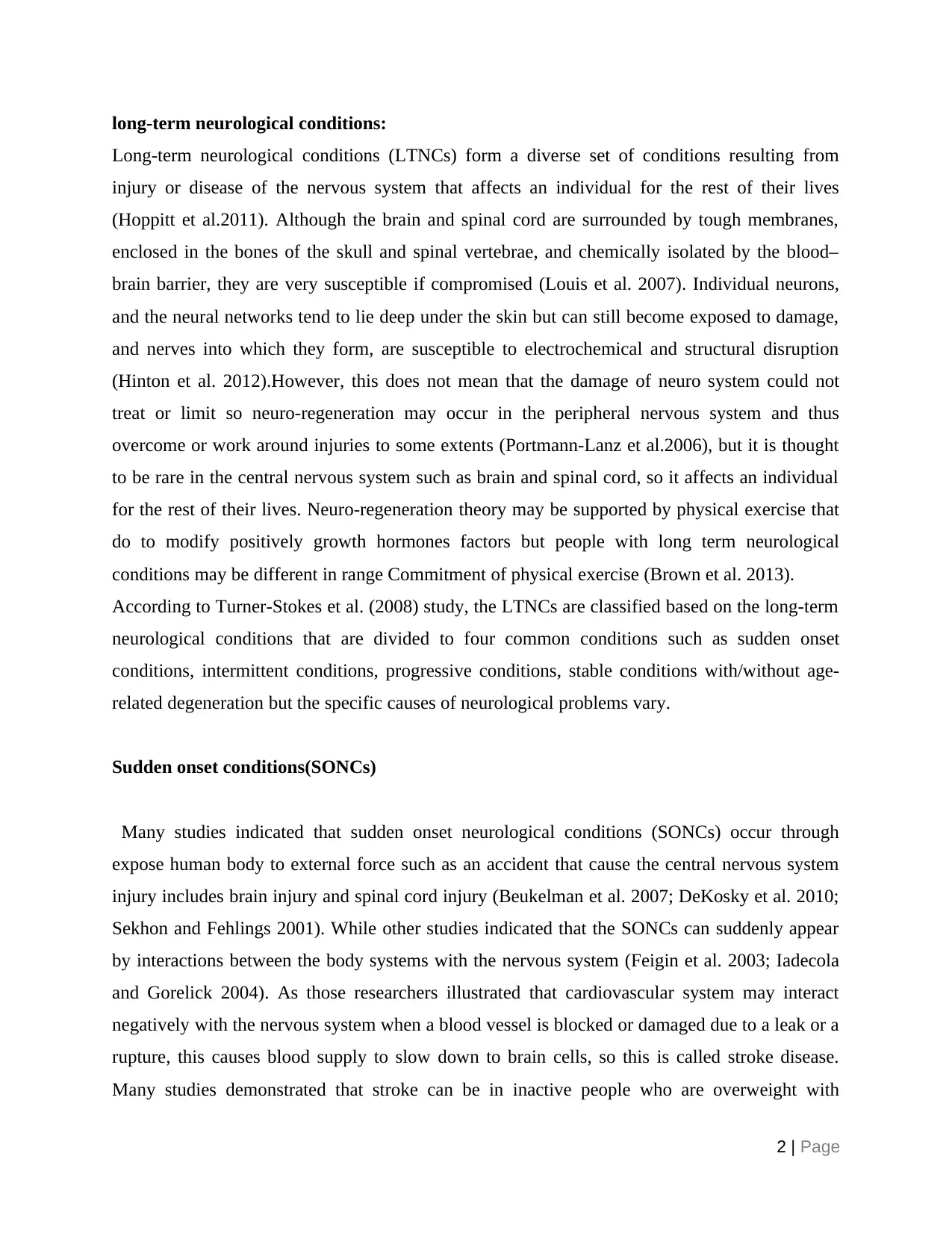
long-term neurological conditions:
Long-term neurological conditions (LTNCs) form a diverse set of conditions resulting from
injury or disease of the nervous system that affects an individual for the rest of their lives
(Hoppitt et al.2011). Although the brain and spinal cord are surrounded by tough membranes,
enclosed in the bones of the skull and spinal vertebrae, and chemically isolated by the blood–
brain barrier, they are very susceptible if compromised (Louis et al. 2007). Individual neurons,
and the neural networks tend to lie deep under the skin but can still become exposed to damage,
and nerves into which they form, are susceptible to electrochemical and structural disruption
(Hinton et al. 2012).However, this does not mean that the damage of neuro system could not
treat or limit so neuro-regeneration may occur in the peripheral nervous system and thus
overcome or work around injuries to some extents (Portmann-Lanz et al.2006), but it is thought
to be rare in the central nervous system such as brain and spinal cord, so it affects an individual
for the rest of their lives. Neuro-regeneration theory may be supported by physical exercise that
do to modify positively growth hormones factors but people with long term neurological
conditions may be different in range Commitment of physical exercise (Brown et al. 2013).
According to Turner-Stokes et al. (2008) study, the LTNCs are classified based on the long-term
neurological conditions that are divided to four common conditions such as sudden onset
conditions, intermittent conditions, progressive conditions, stable conditions with/without age-
related degeneration but the specific causes of neurological problems vary.
Sudden onset conditions(SONCs)
Many studies indicated that sudden onset neurological conditions (SONCs) occur through
expose human body to external force such as an accident that cause the central nervous system
injury includes brain injury and spinal cord injury (Beukelman et al. 2007; DeKosky et al. 2010;
Sekhon and Fehlings 2001). While other studies indicated that the SONCs can suddenly appear
by interactions between the body systems with the nervous system (Feigin et al. 2003; Iadecola
and Gorelick 2004). As those researchers illustrated that cardiovascular system may interact
negatively with the nervous system when a blood vessel is blocked or damaged due to a leak or a
rupture, this causes blood supply to slow down to brain cells, so this is called stroke disease.
Many studies demonstrated that stroke can be in inactive people who are overweight with
2 | Page
Long-term neurological conditions (LTNCs) form a diverse set of conditions resulting from
injury or disease of the nervous system that affects an individual for the rest of their lives
(Hoppitt et al.2011). Although the brain and spinal cord are surrounded by tough membranes,
enclosed in the bones of the skull and spinal vertebrae, and chemically isolated by the blood–
brain barrier, they are very susceptible if compromised (Louis et al. 2007). Individual neurons,
and the neural networks tend to lie deep under the skin but can still become exposed to damage,
and nerves into which they form, are susceptible to electrochemical and structural disruption
(Hinton et al. 2012).However, this does not mean that the damage of neuro system could not
treat or limit so neuro-regeneration may occur in the peripheral nervous system and thus
overcome or work around injuries to some extents (Portmann-Lanz et al.2006), but it is thought
to be rare in the central nervous system such as brain and spinal cord, so it affects an individual
for the rest of their lives. Neuro-regeneration theory may be supported by physical exercise that
do to modify positively growth hormones factors but people with long term neurological
conditions may be different in range Commitment of physical exercise (Brown et al. 2013).
According to Turner-Stokes et al. (2008) study, the LTNCs are classified based on the long-term
neurological conditions that are divided to four common conditions such as sudden onset
conditions, intermittent conditions, progressive conditions, stable conditions with/without age-
related degeneration but the specific causes of neurological problems vary.
Sudden onset conditions(SONCs)
Many studies indicated that sudden onset neurological conditions (SONCs) occur through
expose human body to external force such as an accident that cause the central nervous system
injury includes brain injury and spinal cord injury (Beukelman et al. 2007; DeKosky et al. 2010;
Sekhon and Fehlings 2001). While other studies indicated that the SONCs can suddenly appear
by interactions between the body systems with the nervous system (Feigin et al. 2003; Iadecola
and Gorelick 2004). As those researchers illustrated that cardiovascular system may interact
negatively with the nervous system when a blood vessel is blocked or damaged due to a leak or a
rupture, this causes blood supply to slow down to brain cells, so this is called stroke disease.
Many studies demonstrated that stroke can be in inactive people who are overweight with
2 | Page
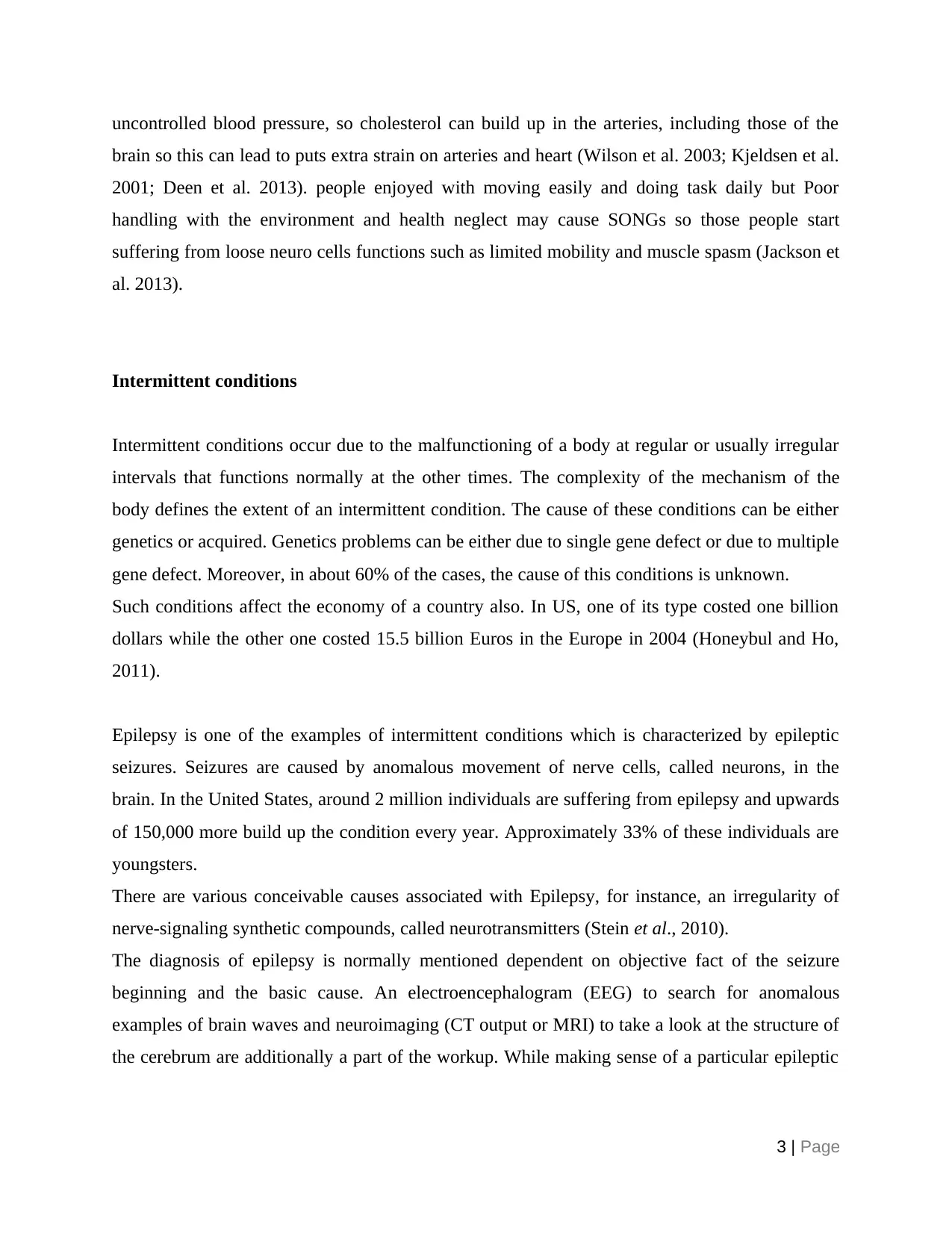
uncontrolled blood pressure, so cholesterol can build up in the arteries, including those of the
brain so this can lead to puts extra strain on arteries and heart (Wilson et al. 2003; Kjeldsen et al.
2001; Deen et al. 2013). people enjoyed with moving easily and doing task daily but Poor
handling with the environment and health neglect may cause SONGs so those people start
suffering from loose neuro cells functions such as limited mobility and muscle spasm (Jackson et
al. 2013).
Intermittent conditions
Intermittent conditions occur due to the malfunctioning of a body at regular or usually irregular
intervals that functions normally at the other times. The complexity of the mechanism of the
body defines the extent of an intermittent condition. The cause of these conditions can be either
genetics or acquired. Genetics problems can be either due to single gene defect or due to multiple
gene defect. Moreover, in about 60% of the cases, the cause of this conditions is unknown.
Such conditions affect the economy of a country also. In US, one of its type costed one billion
dollars while the other one costed 15.5 billion Euros in the Europe in 2004 (Honeybul and Ho,
2011).
Epilepsy is one of the examples of intermittent conditions which is characterized by epileptic
seizures. Seizures are caused by anomalous movement of nerve cells, called neurons, in the
brain. In the United States, around 2 million individuals are suffering from epilepsy and upwards
of 150,000 more build up the condition every year. Approximately 33% of these individuals are
youngsters.
There are various conceivable causes associated with Epilepsy, for instance, an irregularity of
nerve-signaling synthetic compounds, called neurotransmitters (Stein et al., 2010).
The diagnosis of epilepsy is normally mentioned dependent on objective fact of the seizure
beginning and the basic cause. An electroencephalogram (EEG) to search for anomalous
examples of brain waves and neuroimaging (CT output or MRI) to take a look at the structure of
the cerebrum are additionally a part of the workup. While making sense of a particular epileptic
3 | Page
brain so this can lead to puts extra strain on arteries and heart (Wilson et al. 2003; Kjeldsen et al.
2001; Deen et al. 2013). people enjoyed with moving easily and doing task daily but Poor
handling with the environment and health neglect may cause SONGs so those people start
suffering from loose neuro cells functions such as limited mobility and muscle spasm (Jackson et
al. 2013).
Intermittent conditions
Intermittent conditions occur due to the malfunctioning of a body at regular or usually irregular
intervals that functions normally at the other times. The complexity of the mechanism of the
body defines the extent of an intermittent condition. The cause of these conditions can be either
genetics or acquired. Genetics problems can be either due to single gene defect or due to multiple
gene defect. Moreover, in about 60% of the cases, the cause of this conditions is unknown.
Such conditions affect the economy of a country also. In US, one of its type costed one billion
dollars while the other one costed 15.5 billion Euros in the Europe in 2004 (Honeybul and Ho,
2011).
Epilepsy is one of the examples of intermittent conditions which is characterized by epileptic
seizures. Seizures are caused by anomalous movement of nerve cells, called neurons, in the
brain. In the United States, around 2 million individuals are suffering from epilepsy and upwards
of 150,000 more build up the condition every year. Approximately 33% of these individuals are
youngsters.
There are various conceivable causes associated with Epilepsy, for instance, an irregularity of
nerve-signaling synthetic compounds, called neurotransmitters (Stein et al., 2010).
The diagnosis of epilepsy is normally mentioned dependent on objective fact of the seizure
beginning and the basic cause. An electroencephalogram (EEG) to search for anomalous
examples of brain waves and neuroimaging (CT output or MRI) to take a look at the structure of
the cerebrum are additionally a part of the workup. While making sense of a particular epileptic
3 | Page
⊘ This is a preview!⊘
Do you want full access?
Subscribe today to unlock all pages.

Trusted by 1+ million students worldwide
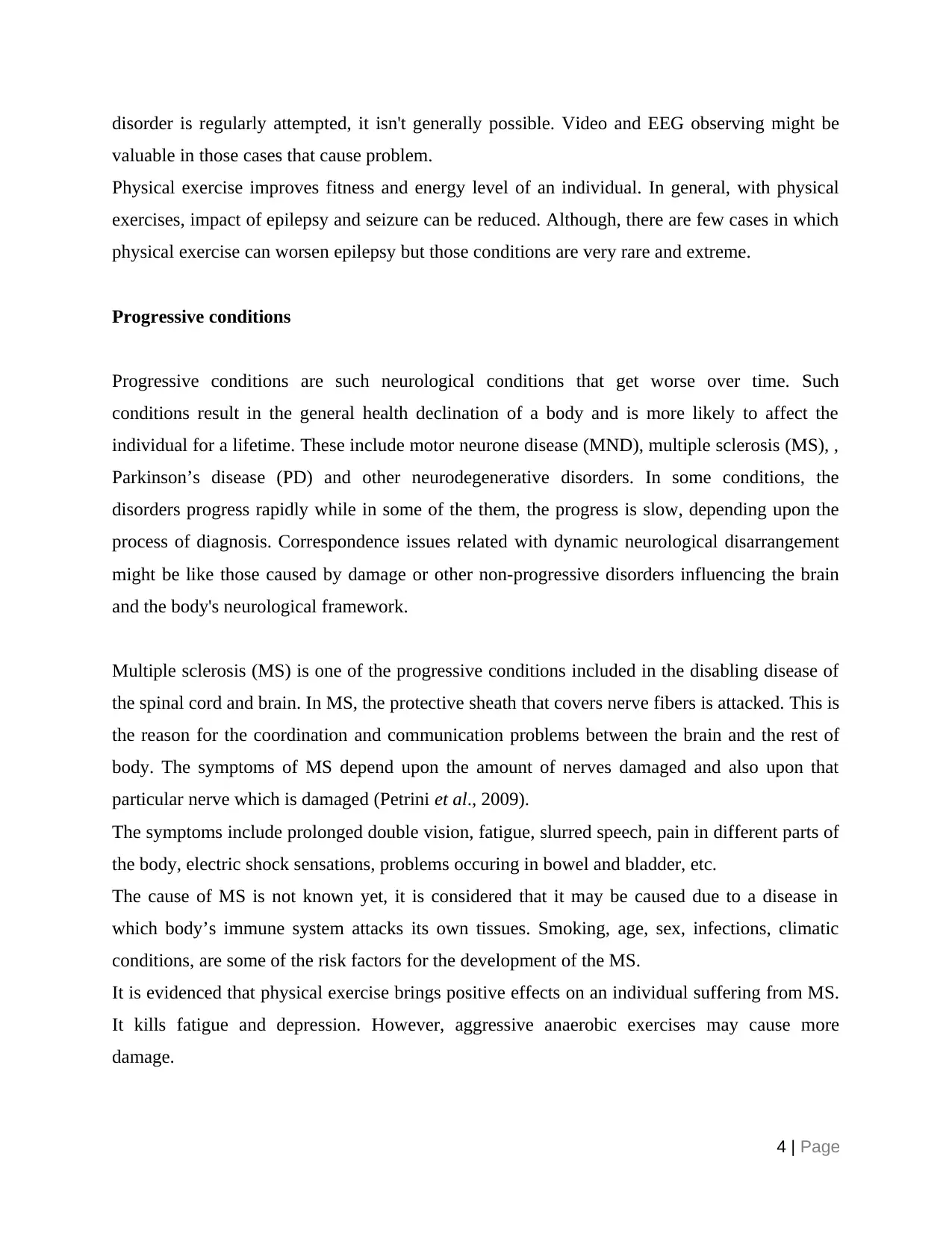
disorder is regularly attempted, it isn't generally possible. Video and EEG observing might be
valuable in those cases that cause problem.
Physical exercise improves fitness and energy level of an individual. In general, with physical
exercises, impact of epilepsy and seizure can be reduced. Although, there are few cases in which
physical exercise can worsen epilepsy but those conditions are very rare and extreme.
Progressive conditions
Progressive conditions are such neurological conditions that get worse over time. Such
conditions result in the general health declination of a body and is more likely to affect the
individual for a lifetime. These include motor neurone disease (MND), multiple sclerosis (MS), ,
Parkinson’s disease (PD) and other neurodegenerative disorders. In some conditions, the
disorders progress rapidly while in some of the them, the progress is slow, depending upon the
process of diagnosis. Correspondence issues related with dynamic neurological disarrangement
might be like those caused by damage or other non-progressive disorders influencing the brain
and the body's neurological framework.
Multiple sclerosis (MS) is one of the progressive conditions included in the disabling disease of
the spinal cord and brain. In MS, the protective sheath that covers nerve fibers is attacked. This is
the reason for the coordination and communication problems between the brain and the rest of
body. The symptoms of MS depend upon the amount of nerves damaged and also upon that
particular nerve which is damaged (Petrini et al., 2009).
The symptoms include prolonged double vision, fatigue, slurred speech, pain in different parts of
the body, electric shock sensations, problems occuring in bowel and bladder, etc.
The cause of MS is not known yet, it is considered that it may be caused due to a disease in
which body’s immune system attacks its own tissues. Smoking, age, sex, infections, climatic
conditions, are some of the risk factors for the development of the MS.
It is evidenced that physical exercise brings positive effects on an individual suffering from MS.
It kills fatigue and depression. However, aggressive anaerobic exercises may cause more
damage.
4 | Page
valuable in those cases that cause problem.
Physical exercise improves fitness and energy level of an individual. In general, with physical
exercises, impact of epilepsy and seizure can be reduced. Although, there are few cases in which
physical exercise can worsen epilepsy but those conditions are very rare and extreme.
Progressive conditions
Progressive conditions are such neurological conditions that get worse over time. Such
conditions result in the general health declination of a body and is more likely to affect the
individual for a lifetime. These include motor neurone disease (MND), multiple sclerosis (MS), ,
Parkinson’s disease (PD) and other neurodegenerative disorders. In some conditions, the
disorders progress rapidly while in some of the them, the progress is slow, depending upon the
process of diagnosis. Correspondence issues related with dynamic neurological disarrangement
might be like those caused by damage or other non-progressive disorders influencing the brain
and the body's neurological framework.
Multiple sclerosis (MS) is one of the progressive conditions included in the disabling disease of
the spinal cord and brain. In MS, the protective sheath that covers nerve fibers is attacked. This is
the reason for the coordination and communication problems between the brain and the rest of
body. The symptoms of MS depend upon the amount of nerves damaged and also upon that
particular nerve which is damaged (Petrini et al., 2009).
The symptoms include prolonged double vision, fatigue, slurred speech, pain in different parts of
the body, electric shock sensations, problems occuring in bowel and bladder, etc.
The cause of MS is not known yet, it is considered that it may be caused due to a disease in
which body’s immune system attacks its own tissues. Smoking, age, sex, infections, climatic
conditions, are some of the risk factors for the development of the MS.
It is evidenced that physical exercise brings positive effects on an individual suffering from MS.
It kills fatigue and depression. However, aggressive anaerobic exercises may cause more
damage.
4 | Page
Paraphrase This Document
Need a fresh take? Get an instant paraphrase of this document with our AI Paraphraser
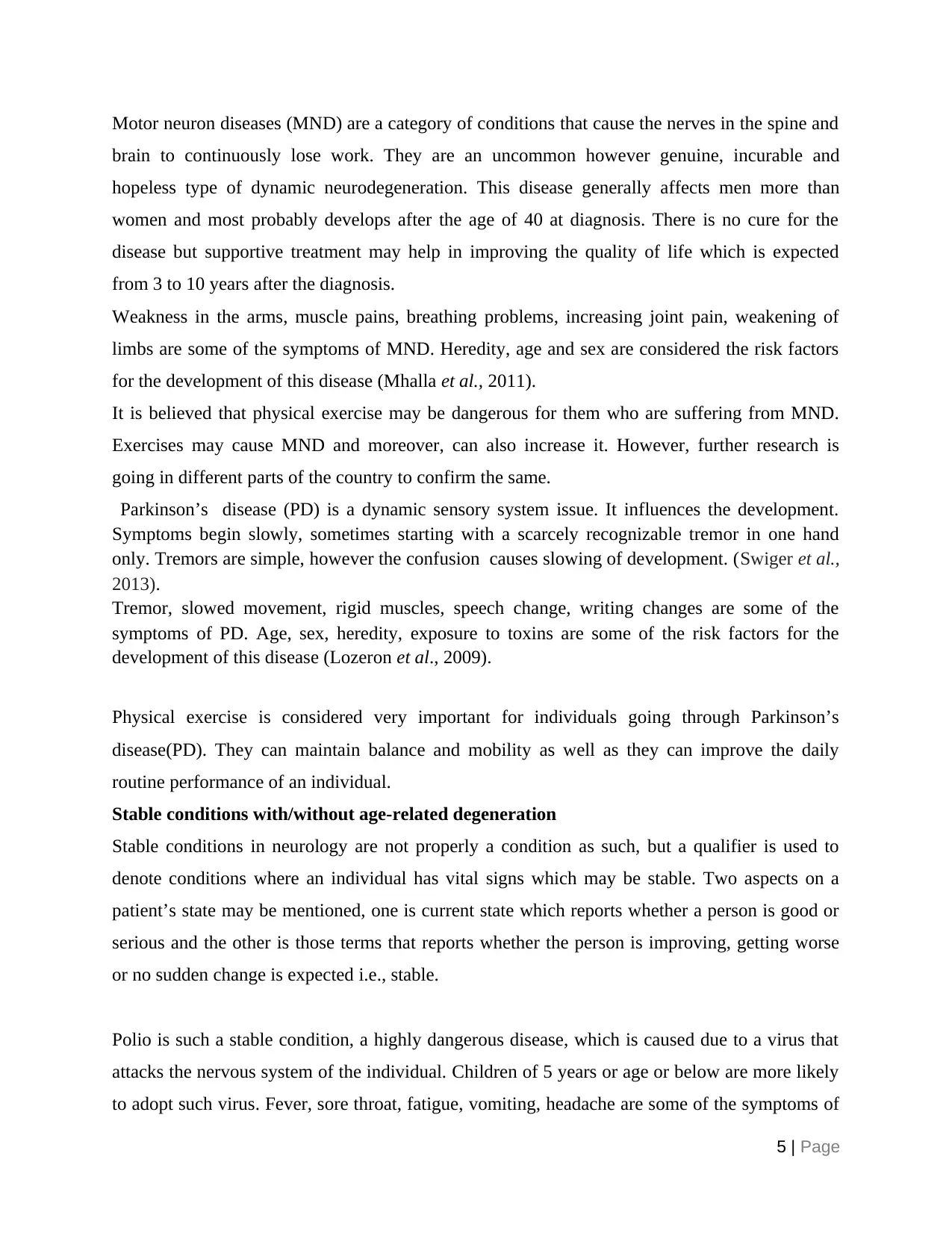
Motor neuron diseases (MND) are a category of conditions that cause the nerves in the spine and
brain to continuously lose work. They are an uncommon however genuine, incurable and
hopeless type of dynamic neurodegeneration. This disease generally affects men more than
women and most probably develops after the age of 40 at diagnosis. There is no cure for the
disease but supportive treatment may help in improving the quality of life which is expected
from 3 to 10 years after the diagnosis.
Weakness in the arms, muscle pains, breathing problems, increasing joint pain, weakening of
limbs are some of the symptoms of MND. Heredity, age and sex are considered the risk factors
for the development of this disease (Mhalla et al., 2011).
It is believed that physical exercise may be dangerous for them who are suffering from MND.
Exercises may cause MND and moreover, can also increase it. However, further research is
going in different parts of the country to confirm the same.
Parkinson’s disease (PD) is a dynamic sensory system issue. It influences the development.
Symptoms begin slowly, sometimes starting with a scarcely recognizable tremor in one hand
only. Tremors are simple, however the confusion causes slowing of development. (Swiger et al.,
2013).
Tremor, slowed movement, rigid muscles, speech change, writing changes are some of the
symptoms of PD. Age, sex, heredity, exposure to toxins are some of the risk factors for the
development of this disease (Lozeron et al., 2009).
Physical exercise is considered very important for individuals going through Parkinson’s
disease(PD). They can maintain balance and mobility as well as they can improve the daily
routine performance of an individual.
Stable conditions with/without age-related degeneration
Stable conditions in neurology are not properly a condition as such, but a qualifier is used to
denote conditions where an individual has vital signs which may be stable. Two aspects on a
patient’s state may be mentioned, one is current state which reports whether a person is good or
serious and the other is those terms that reports whether the person is improving, getting worse
or no sudden change is expected i.e., stable.
Polio is such a stable condition, a highly dangerous disease, which is caused due to a virus that
attacks the nervous system of the individual. Children of 5 years or age or below are more likely
to adopt such virus. Fever, sore throat, fatigue, vomiting, headache are some of the symptoms of
5 | Page
brain to continuously lose work. They are an uncommon however genuine, incurable and
hopeless type of dynamic neurodegeneration. This disease generally affects men more than
women and most probably develops after the age of 40 at diagnosis. There is no cure for the
disease but supportive treatment may help in improving the quality of life which is expected
from 3 to 10 years after the diagnosis.
Weakness in the arms, muscle pains, breathing problems, increasing joint pain, weakening of
limbs are some of the symptoms of MND. Heredity, age and sex are considered the risk factors
for the development of this disease (Mhalla et al., 2011).
It is believed that physical exercise may be dangerous for them who are suffering from MND.
Exercises may cause MND and moreover, can also increase it. However, further research is
going in different parts of the country to confirm the same.
Parkinson’s disease (PD) is a dynamic sensory system issue. It influences the development.
Symptoms begin slowly, sometimes starting with a scarcely recognizable tremor in one hand
only. Tremors are simple, however the confusion causes slowing of development. (Swiger et al.,
2013).
Tremor, slowed movement, rigid muscles, speech change, writing changes are some of the
symptoms of PD. Age, sex, heredity, exposure to toxins are some of the risk factors for the
development of this disease (Lozeron et al., 2009).
Physical exercise is considered very important for individuals going through Parkinson’s
disease(PD). They can maintain balance and mobility as well as they can improve the daily
routine performance of an individual.
Stable conditions with/without age-related degeneration
Stable conditions in neurology are not properly a condition as such, but a qualifier is used to
denote conditions where an individual has vital signs which may be stable. Two aspects on a
patient’s state may be mentioned, one is current state which reports whether a person is good or
serious and the other is those terms that reports whether the person is improving, getting worse
or no sudden change is expected i.e., stable.
Polio is such a stable condition, a highly dangerous disease, which is caused due to a virus that
attacks the nervous system of the individual. Children of 5 years or age or below are more likely
to adopt such virus. Fever, sore throat, fatigue, vomiting, headache are some of the symptoms of
5 | Page
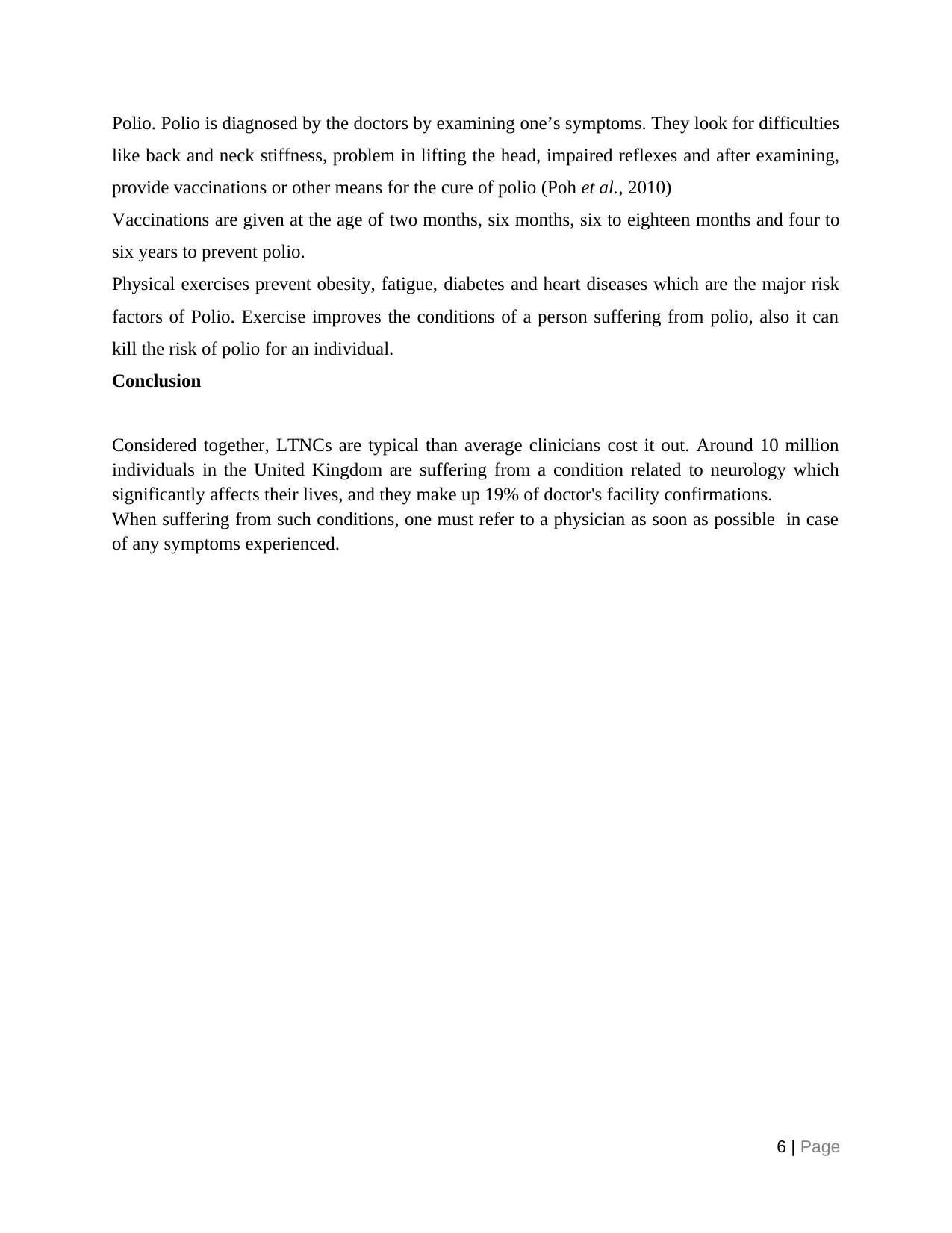
Polio. Polio is diagnosed by the doctors by examining one’s symptoms. They look for difficulties
like back and neck stiffness, problem in lifting the head, impaired reflexes and after examining,
provide vaccinations or other means for the cure of polio (Poh et al., 2010)
Vaccinations are given at the age of two months, six months, six to eighteen months and four to
six years to prevent polio.
Physical exercises prevent obesity, fatigue, diabetes and heart diseases which are the major risk
factors of Polio. Exercise improves the conditions of a person suffering from polio, also it can
kill the risk of polio for an individual.
Conclusion
Considered together, LTNCs are typical than average clinicians cost it out. Around 10 million
individuals in the United Kingdom are suffering from a condition related to neurology which
significantly affects their lives, and they make up 19% of doctor's facility confirmations.
When suffering from such conditions, one must refer to a physician as soon as possible in case
of any symptoms experienced.
6 | Page
like back and neck stiffness, problem in lifting the head, impaired reflexes and after examining,
provide vaccinations or other means for the cure of polio (Poh et al., 2010)
Vaccinations are given at the age of two months, six months, six to eighteen months and four to
six years to prevent polio.
Physical exercises prevent obesity, fatigue, diabetes and heart diseases which are the major risk
factors of Polio. Exercise improves the conditions of a person suffering from polio, also it can
kill the risk of polio for an individual.
Conclusion
Considered together, LTNCs are typical than average clinicians cost it out. Around 10 million
individuals in the United Kingdom are suffering from a condition related to neurology which
significantly affects their lives, and they make up 19% of doctor's facility confirmations.
When suffering from such conditions, one must refer to a physician as soon as possible in case
of any symptoms experienced.
6 | Page
⊘ This is a preview!⊘
Do you want full access?
Subscribe today to unlock all pages.

Trusted by 1+ million students worldwide
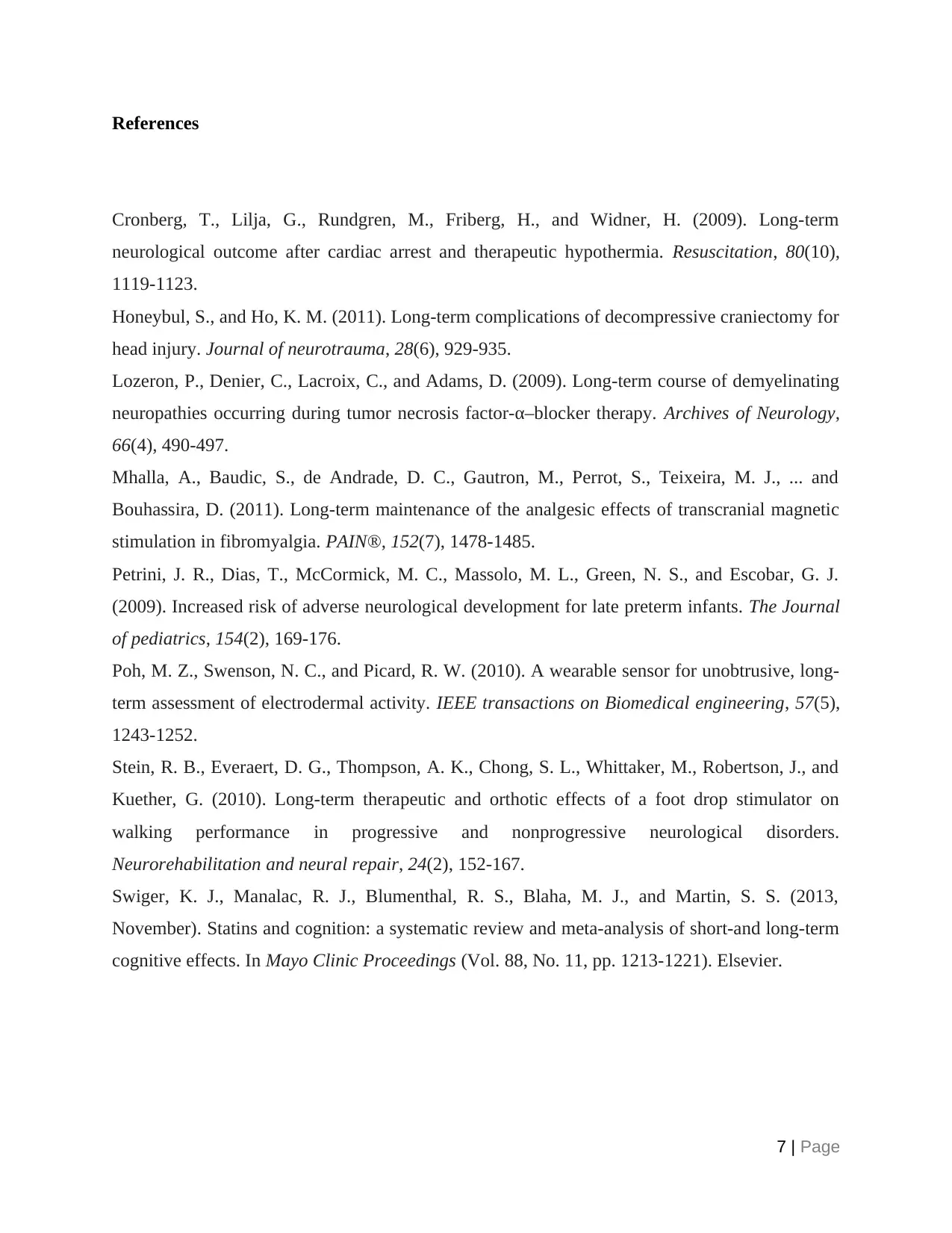
References
Cronberg, T., Lilja, G., Rundgren, M., Friberg, H., and Widner, H. (2009). Long-term
neurological outcome after cardiac arrest and therapeutic hypothermia. Resuscitation, 80(10),
1119-1123.
Honeybul, S., and Ho, K. M. (2011). Long-term complications of decompressive craniectomy for
head injury. Journal of neurotrauma, 28(6), 929-935.
Lozeron, P., Denier, C., Lacroix, C., and Adams, D. (2009). Long-term course of demyelinating
neuropathies occurring during tumor necrosis factor-α–blocker therapy. Archives of Neurology,
66(4), 490-497.
Mhalla, A., Baudic, S., de Andrade, D. C., Gautron, M., Perrot, S., Teixeira, M. J., ... and
Bouhassira, D. (2011). Long-term maintenance of the analgesic effects of transcranial magnetic
stimulation in fibromyalgia. PAIN®, 152(7), 1478-1485.
Petrini, J. R., Dias, T., McCormick, M. C., Massolo, M. L., Green, N. S., and Escobar, G. J.
(2009). Increased risk of adverse neurological development for late preterm infants. The Journal
of pediatrics, 154(2), 169-176.
Poh, M. Z., Swenson, N. C., and Picard, R. W. (2010). A wearable sensor for unobtrusive, long-
term assessment of electrodermal activity. IEEE transactions on Biomedical engineering, 57(5),
1243-1252.
Stein, R. B., Everaert, D. G., Thompson, A. K., Chong, S. L., Whittaker, M., Robertson, J., and
Kuether, G. (2010). Long-term therapeutic and orthotic effects of a foot drop stimulator on
walking performance in progressive and nonprogressive neurological disorders.
Neurorehabilitation and neural repair, 24(2), 152-167.
Swiger, K. J., Manalac, R. J., Blumenthal, R. S., Blaha, M. J., and Martin, S. S. (2013,
November). Statins and cognition: a systematic review and meta-analysis of short-and long-term
cognitive effects. In Mayo Clinic Proceedings (Vol. 88, No. 11, pp. 1213-1221). Elsevier.
7 | Page
Cronberg, T., Lilja, G., Rundgren, M., Friberg, H., and Widner, H. (2009). Long-term
neurological outcome after cardiac arrest and therapeutic hypothermia. Resuscitation, 80(10),
1119-1123.
Honeybul, S., and Ho, K. M. (2011). Long-term complications of decompressive craniectomy for
head injury. Journal of neurotrauma, 28(6), 929-935.
Lozeron, P., Denier, C., Lacroix, C., and Adams, D. (2009). Long-term course of demyelinating
neuropathies occurring during tumor necrosis factor-α–blocker therapy. Archives of Neurology,
66(4), 490-497.
Mhalla, A., Baudic, S., de Andrade, D. C., Gautron, M., Perrot, S., Teixeira, M. J., ... and
Bouhassira, D. (2011). Long-term maintenance of the analgesic effects of transcranial magnetic
stimulation in fibromyalgia. PAIN®, 152(7), 1478-1485.
Petrini, J. R., Dias, T., McCormick, M. C., Massolo, M. L., Green, N. S., and Escobar, G. J.
(2009). Increased risk of adverse neurological development for late preterm infants. The Journal
of pediatrics, 154(2), 169-176.
Poh, M. Z., Swenson, N. C., and Picard, R. W. (2010). A wearable sensor for unobtrusive, long-
term assessment of electrodermal activity. IEEE transactions on Biomedical engineering, 57(5),
1243-1252.
Stein, R. B., Everaert, D. G., Thompson, A. K., Chong, S. L., Whittaker, M., Robertson, J., and
Kuether, G. (2010). Long-term therapeutic and orthotic effects of a foot drop stimulator on
walking performance in progressive and nonprogressive neurological disorders.
Neurorehabilitation and neural repair, 24(2), 152-167.
Swiger, K. J., Manalac, R. J., Blumenthal, R. S., Blaha, M. J., and Martin, S. S. (2013,
November). Statins and cognition: a systematic review and meta-analysis of short-and long-term
cognitive effects. In Mayo Clinic Proceedings (Vol. 88, No. 11, pp. 1213-1221). Elsevier.
7 | Page
1 out of 7
Related Documents
Your All-in-One AI-Powered Toolkit for Academic Success.
+13062052269
info@desklib.com
Available 24*7 on WhatsApp / Email
![[object Object]](/_next/static/media/star-bottom.7253800d.svg)
Unlock your academic potential
Copyright © 2020–2025 A2Z Services. All Rights Reserved. Developed and managed by ZUCOL.





